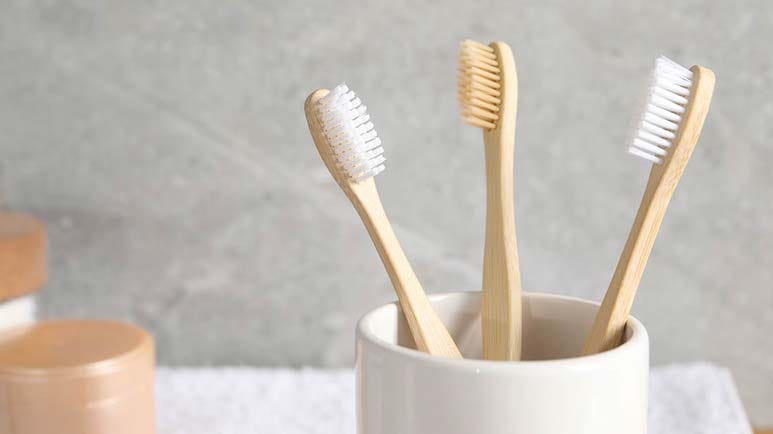How Often to Change Your Toothbrush for a Healthier Mouth
Description
STORY AT-A-GLANCE
Most people need a new toothbrush every three to four months, although there are exceptions when the brush needs to be replaced earlier
Toothbrush contamination occurs naturally from biofilm, moisture, and bathroom aerosols, but you can minimize it by rinsing thoroughly after use, storing upright and uncovered, and keeping your brush several feet from the toilet
An electric toothbrush head follows the same three-month replacement cycle; replace it sooner if indicator bristles fade, the head feels rough, or cleaning efficiency drops
For safe sanitizing, consider soaking the head in 3% hydrogen peroxide for 10 to 15 minutes before air-drying. Avoid boiling, dishwashers, or alcohol-based soaks, which deform bristles and reduce cleaning ability
Here’s a simple rule to follow: When the bristles splay or smell musty, or if you’ve been sick, it’s time for a new toothbrush

You use your toothbrush every day, but here’s the question most people don’t think to ask — How long has it really been since you swapped it for a new one? Most adults hold onto their toothbrush far longer than they should, unaware that the soft nylon bristles quietly break down, collect bacteria, and lose their ability to clean effectively.
Your toothbrush isn’t just a tool; it’s a small ecosystem composed of millions of microorganisms like viruses, bacteria, and other microscopic pathogens.1 In fact, research found that contamination happens almost immediately after the first use and increases over time with continued exposure to oral bacteria and ambient moisture.2 In other words, the longer you hang onto your toothbrush, the more microbial buildup you invite.
How Often Should You Change Your Toothbrush?
At any given moment, your toothbrush carries as much as 1 to 12 million microorganisms.3 These microbes, which thrive on saliva, skin cells, water, and the food stuck in your mouth, cause dense microbial communities, called biofilms, to form along the bristles and head,4 fueled by the moisture and warmth of your bathroom environment. Once these biofilms establish, rinsing alone does not fully remove them — especially when the toothbrush remains damp between use.
It’s for this reason that even if your toothbrush doesn’t show noticeable signs of wear and tear, it is still wise to swap them out with new ones within the recommended time.
So when’s the best time to replace your toothbrush? According to the American Dental Association, three to four months is the optimal lifespan of a toothbrush.5 Around this point, the nylon bristles begin to lose their original shape, flexibility, and tension, which makes them less effective at removing plaque and food particles from teeth and gums.
Each brushing session wears the bristles down slightly — Over time, that daily friction causes nylon, the material which most toothbrush bristles are made of, to break down, weakening its cleaning ability. When nylon breaks down, the tips soften, bend, and gradually lose the sharp edges needed to sweep away plaque.
The result is subtle but significant — Plaque begins to accumulate along the gumline and between teeth even if you’re brushing regularly. You might not notice the difference immediately, but as bristles deform, your toothbrush leaves behind residue that can feed bacteria, leading to cavities, gum inflammation (gingivitis), or bad breath.6
Exceptions That Require Changing Your Toothbrush Sooner
Even though the standard rule is every three to four months, there are several clear reasons to replace a toothbrush earlier — and each comes down to contamination, wear, or hygiene risk.7
The most immediate trigger is illness — Whether it’s a cold, flu, strep throat, or COVID, your toothbrush can hold onto the same microbes your body just fought off. When you brush again, those lingering pathogens can reenter your mouth and throat, raising the risk of reinfection. Remember, toothbrushes could harbor numerous deadly unseen microbes,8 especially when they’re stored in humid environments like your bathroom, where they never dry completely.
<label class="hide-text" contenteditable="false">Text within this block will maintain its original spacing when published</label>Bathrooms are naturally damp, and if you share counter space with family members, the chance of cross-contamination increases. Tossing the old toothbrush and starting fresh after you’ve been sick is a small step that helps your immune system finish the job.
Another reason to replace your toothbrush early is when there’s visible wear or deformation — Bristles that splay outward, forming a rough fan shape, cannot scoop plaque and bacteria effectively.9 Instead, these frayed ends trap debris and toothpaste residue, which dulls the fibers and can even scratch enamel. If your toothbrush looks bent, flattened, or “fuzzy,” it’s done its job.
Pressure also matters — If you brush more than twice a day or apply heavy force, you wear down the nylon bristles faster. People who grip their toothbrush tightly often see splaying in six to eight weeks. That doesn’t mean you need to brush more softly, but it does mean you should expect to replace your brush sooner.
Another early warning sign is odor or discoloration — A toothbrush that smells musty, feels slimy, or shows buildup near the base is holding bacteria. Even though most of these microbes aren’t harmful in small amounts, their presence means the brush is no longer hygienic.
Moisture and storage play a key role — Toothbrushes kept in travel caps, drawers, or closed containers stay damp for hours, giving microbes time to multiply. According to an article from the BBC, covered storage can actually trap bacteria rather than protect against it.10
It’s also advisable to toss your toothbrush if you drop it on a dirty surface — Examples include a public restroom sink or if it falls near the toilet. Brushes that come into contact wit






